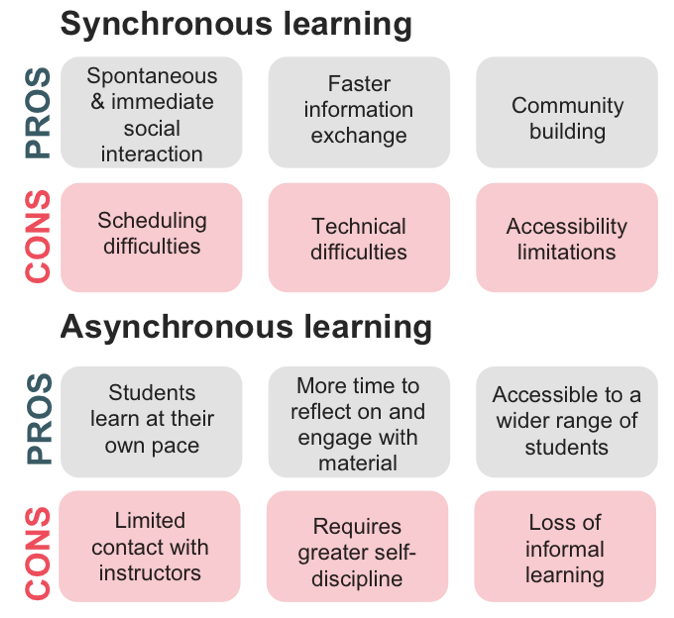The terms “synchronous” and “asynchronous” learning have become ubiquitous in describing online learning although they similarly exist in in-person learning environments. Synchronous learning refers to instructors and students gathering at the same time and (virtual or physical) place and interacting in “real-time”. Asynchronous learning refers to students accessing materials at their own pace and interacting with each other over longer periods.

Rather than characterizing this a dichotomy, it is helpful to view learning experiences as falling along a spectrum of synchronous-to-asynchronous experiences. At the synchronous end of the spectrum lie activities such as live-streaming lectures and participating in video-conference discussions. At the asynchronous end lie activities such as watching pre-recorded lectures, reading assigned materials, and participating in discussion boards. Somewhere in the middle fall hybrid activities that create continuity across these spheres, e.g., assigning students a defined task to do on their own offline during a scheduled synchronous session before coming back online and sharing their reflections with the group.

While optimal course designs vary with learning goals and content to be covered, most online courses will benefit from incorporating both asynchronous and synchronous activities. Synchronous instruction is well-suited to creating immediate social engagement and faster exchanges of information, helping to build a sense of community and clarify misconceptions (Dawson, 2006; Giesbers et al., 2013, 2014; Hrastinski et al., 2010). However, it requires scheduling shared times for students and instructors, often across different time zones, and is prone to technical challenges and accessibility limitations related to strength of Wi-Fi. In contrast, asynchronous instruction is temporally more flexible. This both allows more time for students to explore and engage with material (Davidson-Shivers et al., 2001) and allows access to a wider range of students.
This article is part of a series around bridging synchronous and asynchronous learning, including guides on direct instruction, learning activities, assessment and feedback, and questioning and discussion. Explore additional resources (via the linked text above and the linked articles below) related to this challenge to help you foster engaging synchronous, asynchronous, and hybrid learning experiences across a variety of instructional practices.